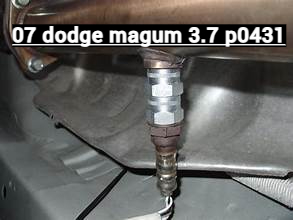Complete Guide to Diagnosing and Fixing the 07 Dodge Magnum 3.7 P0431 Issue

If you own a 2007 Dodge Magnum with a 3.7L engine, you may eventually encounter the P0431 code, which indicates that the Warm Catalyst Efficiency Below Threshold on Bank 2. This diagnostic trouble code (DTC) points toward an issue within your vehicle’s emissions control system, specifically related to the catalytic converter or its associated sensors. Understanding the intricacies of 07 Dodge Magnum 3.7 P0431, its symptoms, causes, and solutions is crucial for maintaining optimal vehicle performance, ensuring compliance with emissions standards, and preventing costly repairs down the line.
Understanding the P0431 Code in Your Dodge Magnum
What Does P0431 Mean?
The P0431 code is a generic OBD-II trouble code that signifies Warm Catalyst Efficiency Below Threshold (Bank 2). In a V6 or V8 engine such as the 3.7L V6 in your 2007 Dodge Magnum, the engine has two banks—Bank 1 and Bank 2—corresponding to the different sides of the engine. Bank 2 refers to one side of the engine’s cylinders, and the code indicates that the catalytic converter on this side is not functioning efficiently when hot.
This code is activated when the oxygen sensors (O2 sensors) downstream of the catalytic converter detect that the converter isn’t effectively reducing pollutants, particularly when the catalyst is at its operating temperature.
How the Code Impacts Vehicle Functionality
When the P0431 code appears, it can impact your vehicle’s overall performance and emissions. Common effects include:
- Decreased fuel efficiency
- Potential loss of power or sluggish acceleration
- Unpleasant exhaust smell
- Failed emissions tests, which can prevent registration or legal driving
Additionally, ignoring this code might lead to further damage to your Dodge vehicle’s exhaust system, resulting in more expensive repairs.
Symptoms of the P0431 in a 2007 Dodge Magnum 3.7
Visual and Performance Indicators
- Illuminated Check Engine Light (CEL): The most obvious sign that the P0431 is active. The CEL will turn on and stay on until the issue is resolved.
- Reduced Engine Performance: Sluggish response, misfires, or hesitation during acceleration may occur due to faulty catalyst readings.
- Increased Emissions and Odor: Noticeable exhaust fumes, usually with a stronger smell of unburned hydrocarbons.
- Failed Emissions Test: If you’re in a region where vehicles undergo emissions inspection, a P0431 can cause you to fail.
- Decreased Fuel Efficiency: The vehicle may consume more fuel due to inefficiencies in the catalytic converter or related sensors.
- Unusual Noises: Rattling or exhaust-related sounds resulting from a damaged or clogged catalytic converter.
Common Causes of the P0431 in a Dodge Magnum 3.7
1. Catalytic Converter Problems
The catalytic converter is the core component that reduces harmful emissions. Over time, it can become contaminated, clogged, or damaged, leading to decreased efficiency and triggering the P0431.
2. Oxygen Sensor Malfunctions
Downstream oxygen sensors play a vital role in monitoring converter efficiency. Faulty sensors, wiring issues, or sensors that have aged or become contaminated can provide inaccurate readings, falsely activating the code.
3. Exhaust Leaks
Cracks or leaks in the exhaust manifold, pipes, or muffler can cause incorrect sensor readings, affecting the catalytic converter’s performance detection.
4. Exhaust System Contamination
Use of leaded fuel, oil leaks, or coolant entering the exhaust system (due to head gasket issues) can foul the catalytic converter, decreasing its effectiveness and causing the P0431.
5. Engine Management Problems
Rich or lean fuel mixtures, misfires, or issues with the vehicle’s ECU calibration can elevate emissions and strain the catalytic converter, potentially setting off the code.
Diagnostic and Testing Procedures for the P0431
1. Visual Inspection
Start by examining the exhaust system for visible damage, cracks, or leaks. Check the wiring harnesses and connectors attached to the oxygen sensors and catalytic converter for corrosion or disconnection.
2. Using an OBD-II Scanner
Connect a reliable OBD-II scanner to retrieve and confirm the P0431 code. Clear the code and monitor if it returns after driving.
3. Testing Oxygen Sensors
Use a multimeter or scan tool to verify the output voltages of upstream and downstream oxygen sensors. Erratic or abnormal readings suggest sensor failure.
4. Examining the Catalytic Converter
Physical inspection might reveal damage; temperature tests can help assess efficiency by comparing temperatures before and after the converter. A significant temperature difference indicates proper functioning.
5. Additional Checks
Review other engine parameters such as fuel trims, misfire codes, or other related DTCs. Addressing underlying issues may resolve multiple codes simultaneously.
Solutions and Repair Strategies for the P0431
1. Replacing the Catalytic Converter
If diagnosed as inefficient or damaged, replacing the catalytic converter is often necessary. For your 07 Dodge Magnum 3.7, OEM parts ensure compatibility, but high-quality aftermarket options can also be reliable.
Proper installation, including ensuring all mounting points and sensors are correctly fitted, is vital. Professional assistance is recommended, especially for catalytic converter replacement given the exhaust system’s complexity.
2. Replacing or Recalibrating Oxygen Sensors
Sensor replacement should be done if sensors are faulty or aged. Ensure sensors are installed in the correct position: upstream (before the converter) and downstream (after the converter). Proper calibration preserves accurate readings and prevents future trouble codes.
3. Repairing Exhaust Leaks
Cracks or leaks in the exhaust system can be repaired by welding or replacing damaged sections. Addressing leaks improves sensor accuracy and overall system efficiency.
4. ECU Updates or Reprogramming
Sometimes a software update or re-flash performed by a certified technician can refine engine and emissions management, reducing false diagnoses of the P0431.
5. Fixing Engine Management Issues
Addressing issues like misfires, oil leaks, or incorrect fuel mixture can restore proper combustion and reduce stress on the catalytic converter, possibly preventing recurrence of the code.
Prevention and Maintenance Tips for Your Dodge Magnum
- Schedule regular diagnostic scans to catch potential issues early.
- Use high-quality, manufacturer-recommended fuels and oils to prevent contamination or fouling of the catalytic converter.
- Inspect the exhaust system periodically for leaks or damage.
- Replace oxygen sensors at recommended intervals or if they start failing.
- Ensure proper engine tuning and timely repairs to prevent excess emissions.
When to Seek Professional Help
If P0431 persists despite repairs, or if complex problems such as ECU reprogramming or catalyst replacement are needed, consulting a certified mechanic is vital. Proper diagnosis ensures that your vehicle remains compliant with emissions standards and operates efficiently.
Summary Table: P0431 Diagnosis & Solutions for 07 Dodge Magnum 3.7
| Issue | Likely Causes | Diagnostic Steps | Recommended Solutions |
|---|---|---|---|
| Illuminated CEL & Poor Performance | Faulty catalytic converter, Sensor malfunction, Exhaust leaks | Visual inspection, OBD-II scan, Sensor testing, Temperature checks | Replace converter, Sensor replacement, Repair exhaust leaks |
| Sensor Inaccuracies | Sensor aging, Wiring issues | Sensor voltage testing, Wiring inspection | Replace oxygen sensors, Repair wiring |
| Persistent Code After Repairs | Underlying engine issues, ECU needing update | Comprehensive diagnosis, ECU reprogramming if necessary | Fix engine faults, Update ECU software |
Frequently Asked Questions About 07 Dodge Magnum 3.7 P0431
- Can I drive with the P0431 code active?
It is possible to drive temporarily, but it can lead to further damage and failed emissions tests. It’s best to diagnose and fix the issue promptly.
- Is replacing the catalytic converter expensive?
Yes, catalytic converters are costly parts, especially OEM versions. However, aftermarket options can reduce costs while maintaining quality.
- How long does it take to fix the P0431?
The time varies based on the cause; sensor replacements are quick, whereas catalytic converter replacements may take several hours.
- Will clearing the code fix the problem?
Clearing the code without fixing the root cause only provides temporary relief. The code is likely to return if underlying issues remain.
- How often should I replace oxygen sensors?
Typically every 60,000 to 100,000 miles, but it depends on driving conditions and sensor quality.
- Can a fuel additive help with catalyst efficiency?
Some fuel additives claim to clean the catalytic converter, but they are not a substitute for proper repair or replacement if needed.
- What are the risks of ignoring the P0431 code?
Potential damage to the engine and exhaust system, increased emissions, and failing vehicle inspections.
By understanding the roots of the 07 Dodge Magnum 3.7 P0431 code, following proper diagnostic procedures, and applying targeted repairs, you can restore your vehicle’s performance and ensure it remains environmentally compliant. Regular maintenance and timely attention to warning signs go a long way in extending your vehicle’s lifespan and saving you money in the long run. For more detailed information and professional assistance, consider consulting certified technicians or referencing official repair manuals.





